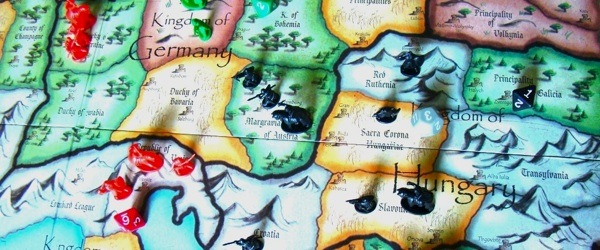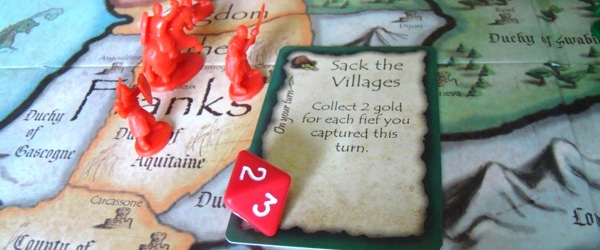Warlords of Europe – Boardgame Review
 Warlords of Europe: An epic strategy game of medieval warfare. Boardgame. Publisher: Conquest Gaming LLC. Developed by Ken Griffin, Kyle Battle, and Russ Rupe. $79.95.
Warlords of Europe: An epic strategy game of medieval warfare. Boardgame. Publisher: Conquest Gaming LLC. Developed by Ken Griffin, Kyle Battle, and Russ Rupe. $79.95.
Passed Inspection: Clever mechanism for handling the Church’s moral authority. The three different decks of cards work well in game play. Rulebook well illustrated and nicely laid out. Nicely mounted map board, plastic pieces have nice details, and cards are relatively easy to handle even for large hands.
Failed Basic: Two examples of the individual phase but no examples of the group phase.
{default}Warlords of Europe is a strategic board game covering 13th-century Western Europe from the southern tip of Sweden to northernmost Mauritania and Algeria, and Ireland to westernmost Turkey. The map is divided into areas grouped into nine kingdoms. The plastic playing pieces represents castles (completed and under construction) and army pieces—warlords, knights, swordsmen (representing dismounted men at arms), archers (bow only, no crossbows), and spearmen. There are three decks of cards: Conquest, Pope, and Merchant. The cards abstract advantages and disadvantages from military action, the Church, and trade. The scenarios mostly focus around the number of players (2–4), suggesting starting areas and limits to the play area on the map.
A game turn has two phases: Individual and Group. The Individual Phase is broken down into a number of steps, with each player going through his/her complete turn before it goes to the next player. The steps are Campaign Maneuvers, Battle, Maneuver Reserves, and Draw Conquest Card.
Campaign Maneuvers get your pieces into place to conduct battles. All army pieces move one area per turn except for the knight, which can move two areas, and the warlord—which not only can move two areas, it can take other pieces with it.
Battle is fought area by area. You roll separately for each army piece, and each type has its own to-hit number (high rolls are good): peasants need 8+, spearmen 7+, archers, swordsmen and warlords 5+, knights 4+. Archers go first, and any enemy pieces removed as a result of the bowmen’s fire do not fight in the subsequent melee round. Battles last until the attacker retreats or one side is completely eliminated. Pieces that move into battle do not get to move later in the same turn even if they have movement left.

In the Maneuver Reserves phase you move your army pieces that have not moved yet this turn. Regular movement rules still apply. If you captured at least one area you can draw a Conquest Card, which can give you an advantage in the next game turn. The two examples provided in the rulebook are clear and useful for seeing how battles work between armies and peasants (unoccupied areas) and between opposing armies.
The Group Phase has the following steps: Draw Pope Card and Victory Check, Taxation, Muster Armies, Deploy Armies, Determine Initiative, and Purchase Merchant Card.
Draw Pope Card has each player drawing a card from the Pope deck. Cards from all three decks list when the card is active and what advantage or disadvantage it provides. After the Pope cards are drawn, check to see if any player has met the victory conditions for the scenario. Taxation is straightforward. You must own at least one castle to collect taxes, and you can get 1 to 3 gold pieces per area you control.
During the Muster Armies phase you purchase army pieces, ranging from 3 gold for a spearman to 10 gold for a warlord. You also pay for mercenaries in this step. The only way to add pieces to your armies is to purchase them or receive them through a card (mostly the Pope cards).
In Deploy Armies you build castles (takes two turns) and get to deploy the armies you purchased in the previous step. The Determine Initiative step has each player rolling an 8-sided die, with the highest choosing which initiative number she/he would like to have for the next game turn. There are four Initiative cards, numbered I-IV; the initiative number is the order in which player turns are played and any other activity that is not simultaneous is resolved. After the highest-rolling player selects an initiative number, the next highest player chooses one, and so on until all players have an initiative number.

The last step in the Group Phase is purchasing a Merchant card. This costs 4 gold and only 1 card may be purchased. Unlike the Individual Phase that has two examples in the rules, there are no examples of the Group Phase provided with the game.
One of the mechanisms I really liked is the way the game represents the moral authority of the Church. Some of the cards have "Papal Disfavor if ignored" printed on them. These cards are normally played on one of your opponents. If the opponent wants to disregard the effects of the card, he/she has to place that card face-up. With one papal disfavor card, that player can no longer draw from the Pope deck. With two cards the player can no longer purchase Merchant cards. Three such cards prevent the player from drawing from the Conquest deck. Since these decks provide many advantages, a player who cannot draw from them can be in serious trouble competing. I did not see in the rules how to remove a Papal Disfavor.
Keep close track of which deck the cards in your "hand" come from, as all the cards have the same back. The front of the cards have a colored border and a symbol matched to the deck—red for Conquest deck (sword and shield), purple for Pope deck (bishop/papal mitre), and green for Merchant deck (bag with coins).
The rulebook is only 12 pages long and has several charts. The charts are small enough that they are repeated in the sections where they are referenced. Each player has a card with the properties chart for the army pieces that also lists the steps for the Individual Phase. The initiative cards list the steps for the Group Phase.

Thanks to the game aids it didn’t take very long to get into the mechanics and be able to focus on planning campaigns. The map is big enough to permit two turns of battling peasants and consolidating a base before needing to confront the other players.
Conquest Gaming suggests that a game can take 2–4 hours and my experience ran very close to that, depending on the number of players and how familiar they were with the rules.
For those who want to play it solitaire I would recommend going through the set-up in the rulebook and making the first game turn’s Individual Phase part of the set-up, as the only card players have at that point is the Initiative card. Don’t look at the Conquest card at the end of each player’s turn until the next game turn. Play through the first Group Phase and make sure each "player" purchases a Merchant card. When each player has cards from all three decks, the game becomes more playable solitaire.
Fans of Axis & Allies–type games and medieval warfare will love this game. Casual gamers ready for something beyond Risk should try Warlords of Europe.
Armchair General Rating: 87
Solitaire Rating: 2 of 5 (5 is entirely suitable for solitaire play)
About the Author
Steven M. Smith has been an Armchair General contributor since 2010. He has a life-long interest in history especially the Napoleonic and Victorian periods. He was the owner of The Simulation Corner gaming retail outlet in Morgantown, West Virginia, until 1983. He is currently a member of the Historical Miniatures Gaming Society and works for Lockheed Martin in Baltimore, Maryland.


0 Comments
Trackbacks/Pingbacks